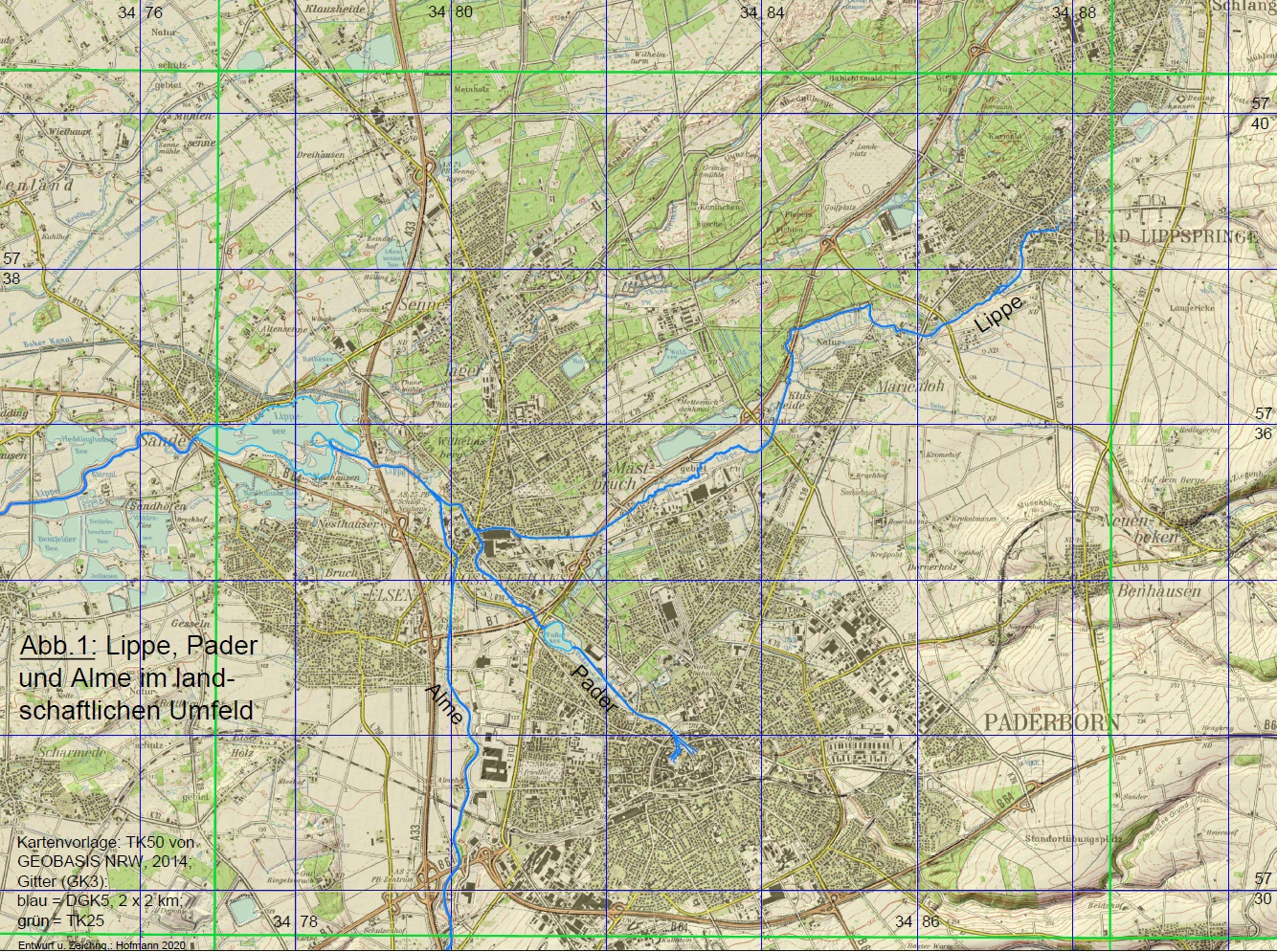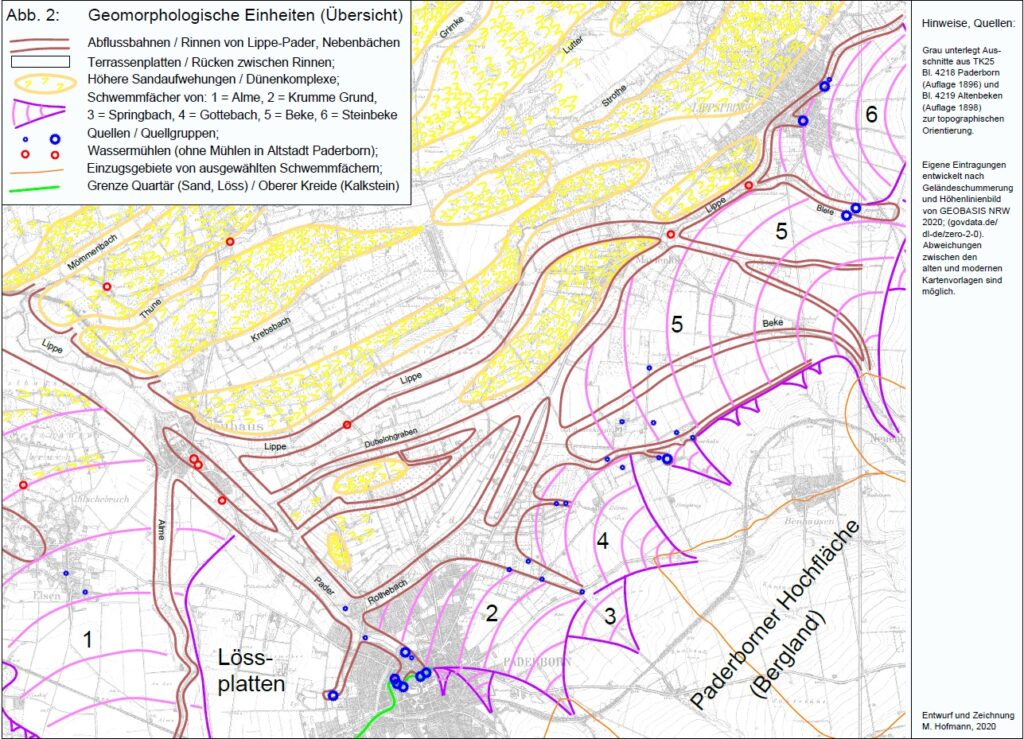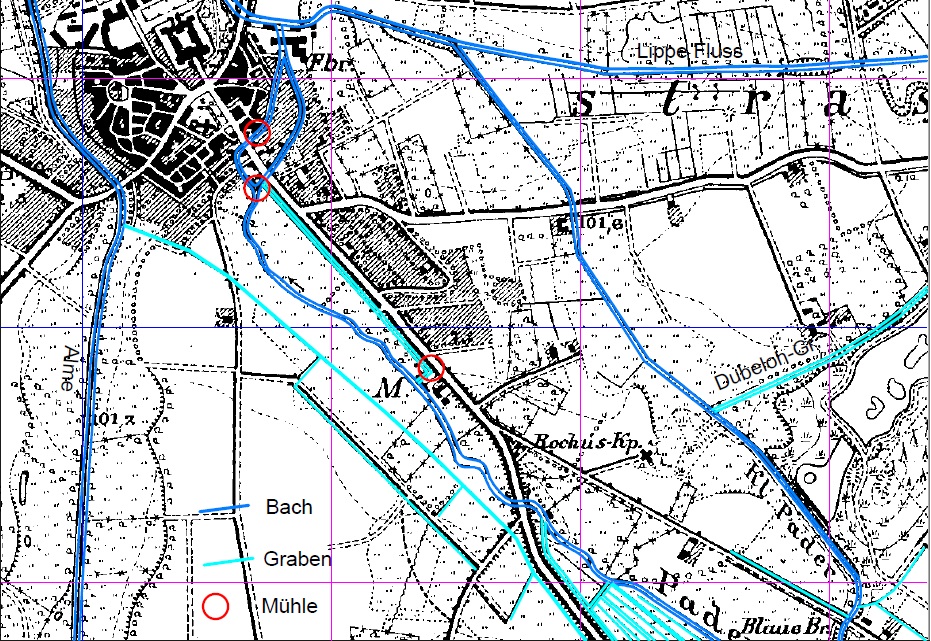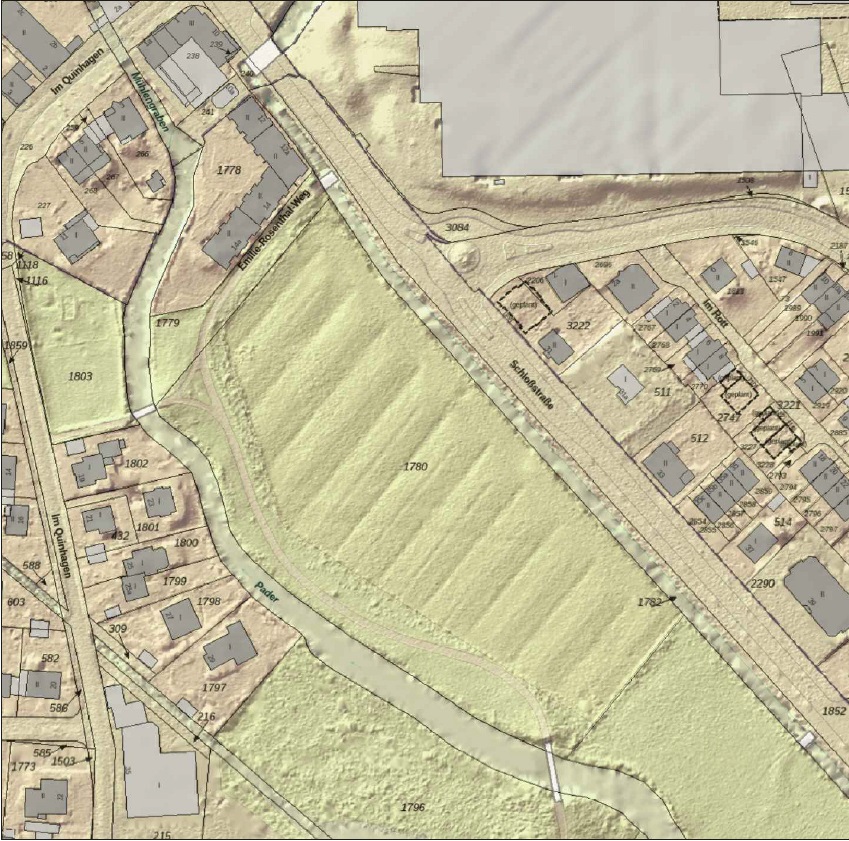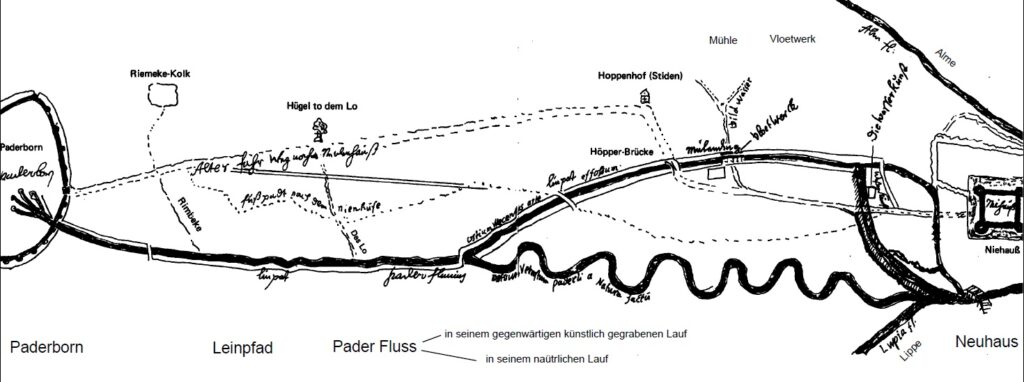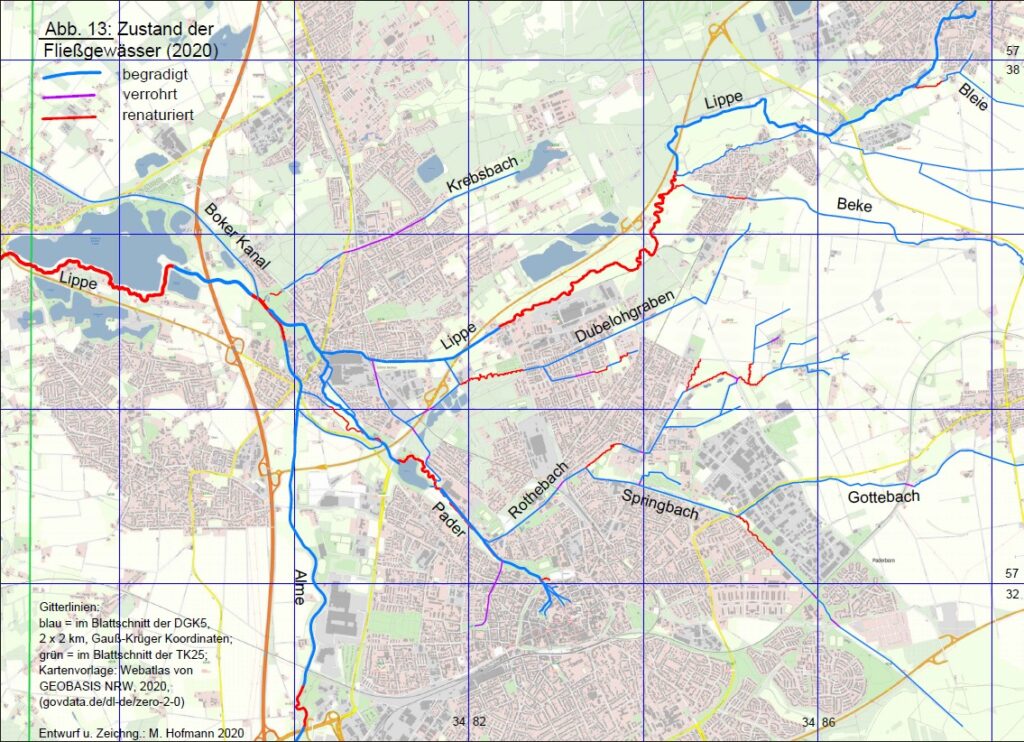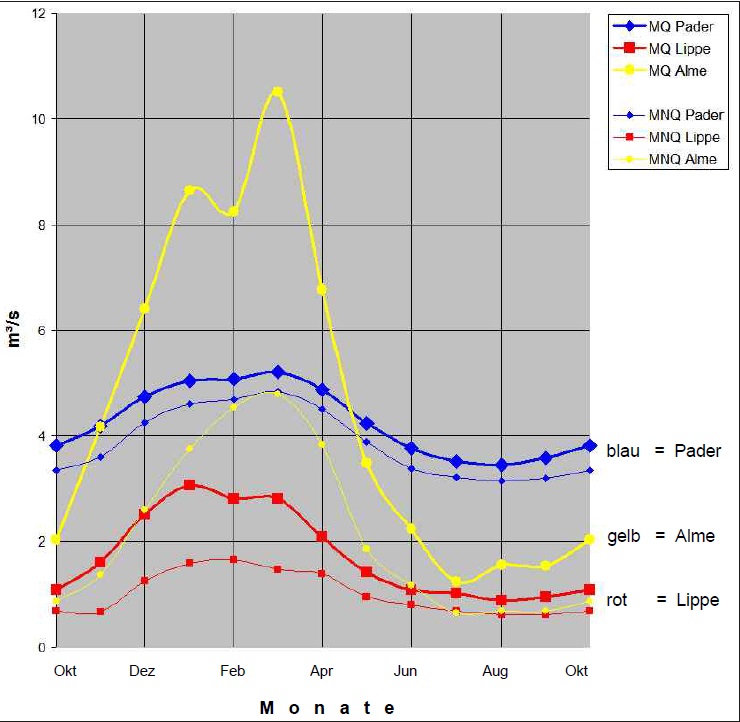Auffenberg, Karl 2018: Die Heidekompanie und ihr Gebiet in der Stadtheide. ln: Heide-Focus 2018. 50 Jahre Heide-kompanie. Paderborn: Bürgerschützenverein Paderborn, 2018, p. 70-79, numerous figures
BZRG AR 2010: Lippeaue. Eine Flusslandschaft im Wandel. Arnsberg: Bezirksregierung Arnsberg, 2010, lV, 48 p., numerous figures
BZRG AR 2018: Schön & eigenwillig: Die Lippeseeumflut in Paderborn-Sande. Entwicklung von 2005 bis 2014. Arnsberg: Bezirksregierung Arnsberg, 2018, 36 p., numerous figures
BZRG DT 2018: An der Lippe geht es weiter … Fortführung der Maßnahmen ober- und unterhalb des Sander Lippesees. Informationsveranstaltung „10 Jahre Lippeumflut“ am 1. Okt. 2015 im Gut Lippesee. Detmold: Bezirksregierung Detmold, 2018, 28 p., numerous figures
Dachner, Bernhard 1991: Beobachtungen zum Abflußverhalten der Pader und der Paderquellen. ln: Südost-Westfalen: Potentiale und Planungsprobleme einer Wachstumsregion. Jahrestagung der Geographischen Kommission für Westfalen in Paderborn. Münster: Geographische Kommission für Westfalen, 1991, p. 65-82, 5 figures, 3 charts; (= Spieker. Landeskundliche Beiträge und Berichte; H.35)
DGJ 2006 ff: Deutsches gewässerkundliches Jahrbuch, Rheingebiet, Teil Ill. Düsseldorf: Landesamt für Wasser und Abfall Nordrhein-Westfalen (LAWA), Abflussjahre 2006 – 2009
Elbers, Bernhard 1998: 200 Jahre Paderborner Stadtheide: Chronik von der Hudezeit bis zur Gegenwart.o.O.; o.j.. (als Manuskript im Stadt- u. Kreisarchiv Paderborn einsehbar).
Evelt, Julius 1876: Über den Ursprung des Ortsnamens “Paderborn”. In: Zeitschrift für Vaterländische Geschichte und Altertumskunde (= Westfälische Zeitschrift), Vol. 34, 1876, Abt. 2, p.169-199
Feige, Wolfgang 2004: Wiesenbewässerung an der Alme und in ihren Nebentälern. ln: Die Warte, Nr.123, [=jg.65, 2004, H.3], p. 8-13, 9 figures
Füller, Matthias 2000: Flösswiesen in Lippe. Zur Technik und ökologischen Bedeutung einer fast vergessenen Wirtschaftsform. ln: Lippische Mitteilungen aus Geschichte und Landeskunde,Bd.69, 2000, p. 331-345, 6 figures
Geyh, Mebus A.; Michel, Gert 2000: Nachhaltige Bewirtschaftung des gespannten und gepumpten Karstgrundwasservorkommens im Paderborner und Bielefelder Raum nach isotopenhydrologischen Ergebnissen. ln: Steirische Beiträge zur Hydrogeologie, 51, 2000, p. 5-56, 27 figures, 6 charts
Grothmann, Detlev a.o. 2020: Chronik der Stadtheide Herausgegeben anlässlich des 100-jährigenJubiläums der Stadtheide-Vereinigung Paderborn e.V.. Erstellt von Detlev Grothmann unter Mitarbeit von Michael Drewniok und Dina Faassen. Paderborn: Verein, 2020, 94 p., maps, figures
Hofmann, Manfred 1991: Sedimenttransport in Fließgewässern. Probleme durch Hochwasserrückhaltebecken und andere wasserbauliche Eingriffe, erläutert an Beispielen aus dem Südosten Westfalens. in: Natur- und Landschaftskunde, Jg.27, 1991, H.4, p. 73-80, 4 figures
Hofmann, Manfred 1993: Quellen in Paderborn – Entstehung, Bedeutung, Schutz. ln: Le Mans und Paderborn. Zwanzig Jahre Partnerschaft zwischen der Université du Maine und der Universität Paderborn. Paderborn: Universität Paderborn, Fach Geographie, 1993, p. 25-41, 6 figures; (= Paderborner Geographische Studien; Vol.5)
Hofmann, Manfred 2019: Eingriffe in Fließgewässer: Beispiel Thunebach / Paderborn-Schloß Neuhaus. In: Die Warte, Nr.183, [=jg.78, 2019, H.4], p. 34-35, 3 figures
Hohmann, Friedrich Gerhard 1986: Bendesloh – Marienloh, Geschichte eines Dorfes. ln: Bendeslo -Marienloh: 1036-1986. Hrsg. anläßlich der 950-jahr-Feier des Stadtteils Marienloh von Engelbert Meyer. Paderborn: Stadt Paderborn, Stadtteil Marienloh, 1986, p. 7-84, figures
Kindl, Harald 1965: Padaribrunno, ein Versuch der Deutung des Ortsnamens von Paderborn. ln: WestfälischeZeitschrift (= Zeitschrift für vaterländische Geschichte und Altertumskunde), Vol. 115, 1965, Abt. 2, p. 283-394, 5 figures, 5 tables
Koch, Josef 1977: Frühe Verkehrsstraßen in der östlichen Westfälischen Bucht. Straßengeschichtliche Untersuchung zur Verkehrslage der Stadt Paderborn. Neuenbeken: Heimatverein Neuenbeken, 1977, XII, 291 p., 95 figures, maps; (= Schriftenreihe des Heimatvereins Neuenbeken; Nr.3)
Krakhecken, Maria 1939: Die Lippe <Fluß>. Münster: Coppenrath, 1939, VIII, 103 p., 14 figures in the text, 22 figures on 8 tables, 1 map-suppl; (= Arbeiten der Geographischen Kommission im Provinzialinstitut für Westfälische Landes- und Volkskunde; H. 2)
Löhnert, Eckehard P. 1990: Beitrag zur Geohydrologie des Karst-Aquifersystems von Paderborn (Nordrhein-Westfalen). In: Neues Jahrbuch für Geologie und Paläontologie. Abhandlungen, Vol. 181, 1990, H. 1-3, p. 519-530, 7 figures, 1 chart
Michel, Gert 1982: Hydrogeologie. In: Erläuterungen zu Blatt 4218 Paderborn. Von Klaus Skupin. Mit Beiträgen von Hans Mertens, Gert Michel, Egbert Seibertz u. Peter Weber. Krefeld: Geologisches Landesamt Nordrhein-Westfalen, 1982, p. 92-107, figure 15-18, chart 10-15; (= Geologische Karte von Nordrhein-Westfalen 1:25.000)
Michel, Gert 1992: Die Curanstalt Inselbad bei Paderborn – ein vergangenes und vergessenes Heilbad. In: Tiefes Grundwasser in Paderborn. Paderborn: Stadt Paderborn, Stadtwerke, 1992, p. 129-138, 2 figures, 1 chart
Moritz, Gerhard 1997: Ehemalige Flößwiesen im Stadtgebiet von Paderborn und deren Bedeutung für den Naturschutz. In: Die Warte, Nr. 95, [= Jg. 58, 1997, H.4], p.9-12, figure
Moritz, Gerhard 1999: Flößwiesen: Biotopschutz im Einklang mit Kulturgeschichte. Hsrg.v. Amt für Umweltschutz und Grünflächen der Stadt Paderborn. Paderborn: Stadt Paderborn, 1999, 16 S., Abb.; (= Schriftenreihe Naturschutz und Landschaftspflege in Paderborn; H.4)
NZO 2013_1: Wiederherstellung der ökologischen Durchgängigkeit der Pader im Bereich des HRB Padersee. Antrag auf Genehmigung nach § 68 WHG. Nichttechnische Zusammenfassung. Im Auftrag der Stadt Paderborn. Bielefeld: Naturschutzzentrum Ostwestfalen (NZO), 2013, 14 p., figures
NZO 2013_2: Rothebach – Fließgewässer in Paderborn. Hrsg.v. Stadt Paderborn, Amt für Umweltschutz und Grünflächen. Bearb.v. NZO. Bielefeld: Naturschutzzentrum Ostwestfalen (NZO), 2013, 20 p., numerous figures
NZO 2014: Renaturierung der Lippe im Bereich Tallhof – Was hat sich inzwischen getan?. Gewässerkonferenz der Bezirksregierung Detmold am 19.11.2014. Bielefeld: Naturschutzzentrum Ostwestfalen (NZO), 2014, 63 p., numerous figures
NZO 2018: Umgestaltung des Rothebaches im Seskerbruch. Antrag auf Genehmigung nach § 68 WHG. Erläuterungsbericht. Im Auftrag des Stadtentwässerungsbetriebs Paderborn (STEB). Bielefeld: Naturschutzzentrum Ostwestfalen (NZO), 2018, 38 p., numerous figures
Stille, Hans 1903: Geologisch-hydrologische Verhältnisse im Ursprungsgebiet der Paderquellen zu Paderborn. Berlin: Königlich Preußische Geologische Landesanstalt u. Bergakademie, 1903, V, 129 p., 3 figures, 6 tables; (= Abhandlungen der Königlich-Preußischen Geologischen Landesanstalt und Bergakademie. N.F.; H. 38)
Ströhmer, Michael 2019: Wirtschaftsregion Pader 1950 – 1300. Neue historische Erkenntnisse und Perspektiven. Manuskript eines Vortrag vor Verein „Freunde der Pader“, (text + slides); Paderborn: Verein, 2019, 18 p., 1 suppl. with charts (www.freunde-der-pader>die-pader>wirtschaft-energie); viewed on 16 July 2020
Struckmeier, Wilhelm 1990: Wasserhaushalt und hydrologische Systemanalyse des Münsterschen Beckens. Düsseldorf: Landesamt für Wasser und Abfall Nordrhein-Westfalen (LAWA), 1990, 71 p., 21 figures, 13 charts in the text; 5 maps in suppl.; (= Wasser und Abfall: LWA Schriftenreihe; H. 45)
STUA 2005: Die Lippe bei Paderborn-Sande – jetzt wieder im Fluss. Broschüre: Hrsg.v. Staatliches Umweltamt Lippstadt. Gestaltet v. Naturschutzzentrum Ostwestfalen (NZO). Lippstadt: Staatliches Umweltamt Lippstadt (StUA), 2005, 21 p., numerous figures
Völkel, Jana; Fäßler, Peter E. 2014: Die Ottilienquelle, das Inselbad und die Curanstalt Inselbad bei Paderborn. Eine Dokumentation. Paderborn: Universität Paderborn, Historisches Institut, 2014, 34 p., 11 figures, Tab.

